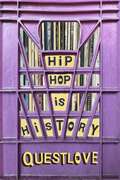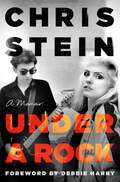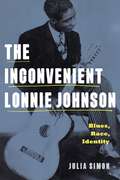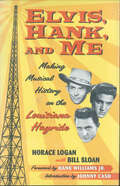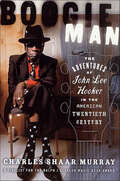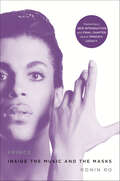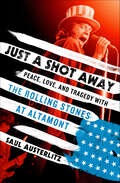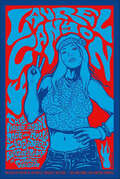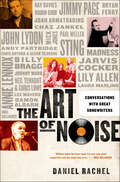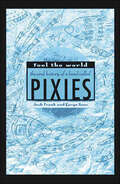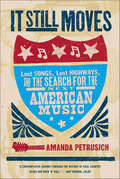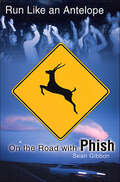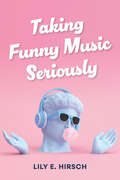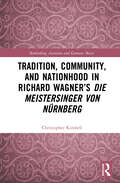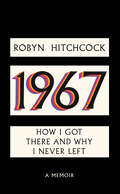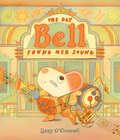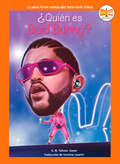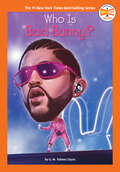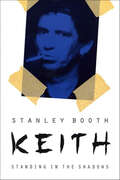- Table View
- List View
Hip-Hop Is History
by QuestloveThis is a book only Questlove could have written: a perceptive and personal reflection on the first half-century of hip-hop.When hip-hop first emerged in the 1970s, it wasn’t expected to become the cultural force it is today. But for a young Black kid growing up in a musical family in Philadelphia, it was everything. He stayed up late to hear the newest songs on the radio. He saved his money to buy vinyl as soon as it landed. He even started to try to make his own songs. That kid was Questlove, and decades later, he is a six-time Grammy Award–winning musician, an Academy Award–winning filmmaker, a New York Times bestselling author, a producer, an entrepreneur, a cofounder of one of hip-hop’s defining acts (the Roots), and the genre’s unofficial in-house historian.In this landmark book, Hip-Hop Is History, Questlove skillfully traces the creative and cultural forces that made and shaped hip-hop, highlighting both the forgotten but influential gems and the undeniable chart-topping hits—and weaves it all together with the stories no one else knows. It is at once an intimate, sharply observed story of a cultural revolution and a sweeping, grand theory of the evolution of the great artistic movement of our time. And Questlove, of course, approaches it with not only the encyclopedic fluency and passion of an obsessive fan but also the expertise and originality of an innovative participant. Hip-hop is history, and also his history.
Under a Rock: A Memoir
by Chris SteinForeword by Debbie Harry"A Downtown Memory" by Romy AshbyDebbie Harry defined iconic band Blondie’s look. Chris Stein—her performing partner, lover, and lifelong friend—was its architect and defined its sound. “Parallel Lines”, their third album, catapulted to #1, sold 20 million copies, and launched singles like “Heart of Glass”, "Hangin' On the Telephone," and “One Way or Another”, providing the beat when Bianca Jagger and Halston danced at Studio 54 and the soundtrack to every 1970’s punk-soundtracked romance. Chris Stein knows how to tell a story. Under A Rock is his nothing-spared autobiography. It's about the founding of the band, ascending to the heights of pop success, and the hazards of fortune.Famous names march through these pages—Warhol, Bowie, Jean-Michel Basquiat, and more–but you can get famous names anywhere. What you can’t get anywhere else is a plunge into the moments that made a giant 1980's artistic sensation. Stein takes us there in this revelatory, propulsive, distinctive memoir.
The Inconvenient Lonnie Johnson: Blues, Race, Identity (American Music History)
by Julia SimonLonnie Johnson is a blues legend. His virtuosity on the blues guitar is second to none, and his influence on artists from T-Bone Walker and B. B. King to Eric Clapton is well established. Yet Johnson mastered multiple instruments. He recorded with jazz icons such as Duke Ellington and Louis Armstrong, and he played vaudeville music, ballads, and popular songs.In this book, Julia Simon takes a closer look at Johnson’s musical legacy. Considering the full body of his work, Simon presents detailed analyses of Johnson’s music—his lyrics, technique, and styles—with particular attention to its sociohistorical context. Born in 1894 in New Orleans, Johnson's early experiences were shaped by French colonial understandings of race that challenge the Black-white binary. His performances call into question not only conventional understandings of race but also fixed notions of identity. Johnson was able to cross generic, stylistic, and other boundaries almost effortlessly, displaying astonishing adaptability across a corpus of music produced over six decades. Simon introduces us to a musical innovator and a performer keenly aware of his audience and the social categories of race, class, and gender that conditioned the music of his time. Lonnie Johnson’s music challenges us to think about not only what we recognize and value in “the blues” but also what we leave unexamined, cannot account for, or choose not to hear. The Inconvenient Lonnie Johnson provides a reassessment of Johnson’s musical legacy and complicates basic assumptions about the blues, its production, and its reception.
Elvis, Hank, and Me: Making Musical History on the Louisiana Hayride
by Bill Sloan Horace LoganIn 1948, Horace "Hoss" Logan, a young radio producer in Shreveport, Louisiana, started booking talent for a new weekly music show called the Louisiana Hayride. Performed for a live audience and broadcast nationally over the CBS Radio network, the show became known as the "Cradle of the Stars." In this affectionate memoir, Hoss Logan recalls the Hayride's heyday with behind-the-scenes anecdotes about the dozens of musicians he knew and nurtured, including Johnny Cash, Johnny Horton, George Jones, Willie Nelson, Elvis Presley, Jim Reeves, Kitty Wells, Slim Whitman, Hank Williams, Faron Young, and many more. As producer, emcee, and friend to the Hayride performers, Logan gives us a personal look into musical history - from Hank Williams's ups and downs to the teenage Elvis's first performance on national radio to the ways the Hayride's many emerging stars expanded our idea about what country music could be.
Boogie Man: The Adventures of John Lee Hooker in the American Twentieth Century
by Charles Shaar MurrayAcclaimed writer Charles Shaar Murray's Boogie Man is the authorized and authoritative biography of an extraordinary musician. Murray was given unparalleled access to Hooker, and he lets the man from Clarksdale, Mississippi, tell his own story. "Everything you read on album covers is not true, and every album reads different," he told Murray. Murray helps Hooker set the record straight, disentangling the myths and legends from truths so rock-ribbed that we understand, as if for the first time, why they have provided the source for a lifetime of unforgettable sound.Murray weaves together Hooker's life and music to reveal their indissoluble bonds. Yet Boogie Man is far more than merely an accomplished and brilliant biography of one man; it gives an account of an entire art form. Grounded in a time and place in American culture, the blues are universal, and in the hands of the greatest practitioners its power resides in the miracle of using despair to transcend it. "The preacher's mantle," Murray tells us, "passes to the bluesman." This bluesman traveled a hard road out of the American South, from obscurity to adulation and back-and back again. John Lee Hooker has seen it all and sung it all, and his music is both a living legacy and an American treasure. Here is the book that does him and his music full justice.
Prince: Inside the Music and the Masks
by Ronin RoWith a brand-new introduction and chapter that cover the last five year's of Prince's life and work and his untimely death in April 2016.In his three decades of recording, Prince had nearly thirty albums hit the Billboard Top 100. He is the only artist since the Beatles to have a number-one song, movie, and single at the same time. Prince's trajectory—from a teenage unknown in Minneapolis to an idol and Rock and Roll Hall of Famer—won him millions of adoring fans the world over. Prince is the first book to give full treatment to his thirty-five-year career. Acclaimed music journalist Ronin Ro traces Prince's rise from anonymity in the late 70s, to his catapult to stardom in the 80s, to his reemergence in the twenty-first century as an artistic icon. Ro expertly chronicles his music and career, showing how Prince and his albums helped define and inspire a generation. Along the way, Prince confronted labels, fostered other young talents, and took ownership of his music, making a profound mark on the entertainment industry and pop culture.
Just a Shot Away: Peace, Love, and Tragedy with the Rolling Stones at Altamont
by Saul Austerlitz“The most blisteringly impassioned music book of the season.” —New York Times Book ReviewA thrilling account of the Altamont Festival—and the dark side of the ‘60s.If Woodstock tied the ideals of the '60s together, Altamont unraveled them. In Just a Shot Away, writer and critic Saul Austerlitz tells the story of “Woodstock West,” where the Rolling Stones hoped to end their 1969 American tour triumphantly with the help of the Grateful Dead, the Jefferson Airplane, and 300,000 fans. Instead the concert featured a harrowing series of disasters, starting with the concert’s haphazard planning. The bad acid kicked in early. The Hells Angels, hired to handle security, began to prey on the concertgoers. And not long after the Rolling Stones went on, an 18-year-old African-American named Meredith Hunter was stabbed by the Angels in front of the stage.The show, and the Woodstock high, were over. Austerlitz shows how Hunter’s death came to symbolize the end of an era while the trial of his accused murderer epitomized the racial tensions that still underlie America. He also finds a silver lining in the concert in how Rolling Stone’s coverage of it helped create a new form of music journalism, while the making of the movie about Altamont, Gimme Shelter, birthed new forms of documentary. Using scores of new interviews with Paul Kantner, Jann Wenner, journalist John Burks, filmmaker Joan Churchill, and many members of the Rolling Stones' inner circle, as well as Meredith Hunter's family, Austerlitz shows that you can’t understand the ‘60s or rock and roll if you don’t come to grips with Altamont.
Laurel Canyon: The Inside Story of Rock-and-Roll's Legendary Neighborhood
by Michael WalkerMichael Walker’s Laurel Canyon presents the inside story of the once hottest rock and roll neighborhood in LA.In the late sixties and early seventies, an impromptu collection of musicians colonized a eucalyptus-scented canyon deep in the Hollywood Hills of Los Angeles and melded folk, rock, and savvy American pop into a sound that conquered the world as thoroughly as the songs of the Beatles and the Rolling Stones had before them. Thirty years later, the music made in Laurel Canyon continues to pour from radios, iPods, and concert stages around the world. During the canyon's golden era, the musicians who lived and worked there scored dozens of landmark hits, from "California Dreamin'" to "Suite: Judy Blue Eyes" to "It's Too Late," selling tens of millions of records and resetting the thermostat of pop culture.In Laurel Canyon, veteran journalist Michael Walker tells the inside story of this unprecedented gathering of some of the baby boomer's leading musical lights—including Joni Mitchell; Jim Morrison; Crosby, Stills, and Nash; John Mayall; the Mamas and the Papas; Carole King; the Eagles; and Frank Zappa, to name just a few—who turned Los Angeles into the music capital of the world and forever changed the way popular music is recorded, marketed, and consumed.
The Art of Noise: Conversations with Great Songwriters
by Daniel RachelTHE ART OF NOISE offers an unprecedented collection of insightful, of-the-moment conversations with twenty-seven great British songwriters and composers. They discuss everything from their individual approaches to writing, to the inspiration behind their most successful songs, to the techniques and methods they have independently developed to foster their creativity. Contributors include: Sting * Ray Davies * Robin Gibb * Jimmy Page * Joan Armatrading * Noel Gallagher * Lily Allen * Annie Lennox * Damon Albarn * Noel Gallagher * Laura Marling * Paul Weller * Johnny Marr * and many more Musician-turned-author Daniel Rachel approaches each interview with an impressive depth of understanding—of the practice of songwriting, but also of each musician's catalog. The result is a collection of conversations that's probing, informed, and altogether entertaining—what contributor Noel Gallagher called "without doubt the finest book I've ever read about songwriters and the songs they write." The collected experience of these songwriters makes this book the essential word of songwriting—as spoken by the songwriters themselves.
Fool the World: The Oral History of a Band Called Pixies
by Josh Frank Caryn GanzIt's the 1980s and the rock landscape is littered with massive hair, synthesizers, and monster riffs, but there is an alternative being born in the sleepy East of America-we just don't know it yet.Before the Internet, MTV, and iPods provided far-off music fans with information and communities-and before Nirvana-kids across the world grew up in relative isolation, dependent on mix tapes and self-created art to slowly spread scenes and trends. It was under these conditions that four young musicians found one another in Boston, Massachusetts, and started a band called Pixies.During their initial seven-year career, Pixies would play some of Europe's most gigantic festivals, keep the press guessing, and cultivate a fervid international fan base hungry for more and more of their unique surf punk. The band worked fast, cranking out four albums at a breakneck pace, but ultimately pressures and personality clashes took their toll: Pixies broke up just as bands were singing their praises as the rock'n'roll innovators. For twelve years, a Pixies reunion seemed impossible, but a sudden announcement in 2004 proclaimed the unthinkable-Pixies were getting back together. Their extremely successful reunion tour finally gave the group something they'd always lacked in their homeland: proof that their bone-rattling music had left an indelible impact. Fool the World tells Pixies' story in the words of those who lived it, from the band members to studio owners, from A&R executives, producers, and visual artists who worked with them to admirers of their music, such as Bono, PJ Harvey, Beck, and Perry Farrell. With new cartoons by Trompe Le Monde illustrator Steven Appleby, Fool the World is a complete journey through the life, death, and rebirth of one of the most influential bands of all time.
It Still Moves: Lost Songs, Lost Highways, and the Search for the Next American Music
by Amanda Petrusich"Where lies the boundary between meaning and sentiment? Between memory and nostalgia? America and Americana? What is and what was? Does it move?"--Donovon Hohn, A Romance of RustPart travelogue, part cultural criticism, part music appreciation, It Still Moves does for today's avant folk scene what Greil Marcus did for Dylan and The Basement Tapes. Amanda Petrusich outlines the sounds of the new, weird America—honoring the rich tradition of gospel, bluegrass, country, folk, and rock that feeds it, while simultaneously exploring the American character as personified in all of these genres historically. Through interviews, road stories, geographical and sociological interpretations, and detailed music criticism, Petrusich traces the rise of Americana music from its gospel origins through its new and compelling incarnations (as evidenced in bands and artists from Elvis to Iron and Wine, the Carter Family to Animal Collective, Johnny Cash to Will Oldham) and explores how the genre is adapting to the twenty-first century. Ultimately the book is an examination of all things American: guitars, cars, kids, motion, passion, enterprise, and change, in a fervent attempt to reconcile the American past with the American present, using only dusty records and highway maps as guides.
Run Like an Antelope: On the Road with Phish
by Sean GibbonOne journalist's wild summer on the road with the world's most popular cult rock band, Phish.Despite their enormous success and their status as America's biggest cult rock and roll band, Phish remains an enigma. Each of their albums has sold more than 500,000 copies, and their concerts sell out instantly, but the band makes a virtue of ignoring the mainstream, and the fans rather prefer it that way. In Run Like an Antelope: On the Road with Phish, Sean Gibbon deftly and hilariously chronicles this unique musical subculture.Inspired by the offbeat road stories of Hunter S. Thompson and Bill Bryson, among others, Gibbon resolved to follow Phish and their kite's tail of hundreds of thousands of followers on their 1999 summer tour. What he discovered is a new kind of American tribe: a mixture of aging, resigned Deadheads, wealthy college kids, and dedicated Phishheads, all bound together by their belief in the band, passion for the music, and energetic spirit, which transform Phish into an experience. His ensuing adventures among the Phish fans constitute a memorable, insightful, uproarious odyssey into this new frontier of American pop tribalism. Whether he's being kidnapped by a group of ebullient Georgia Tech coeds, or being serenaded by devoted fans on the institution of Phish, Gibbon navigates the wild, fascinating Phish experience with verve and a keen eye, brilliantly communicating both the enormous energy of the band's music and the distinct character of their fans.
Taking Funny Music Seriously (Comedy & Culture)
by Lily E. HirschTake funny music seriously! Though often dismissed as silly or derivative, funny music, Lily E. Hirsch argues, is incredibly creative and dynamic, serving multiple aims from the celebratory to the rebellious, the entertaining to the mentally uplifting. Music can be a rich site for humor, with so many opportunities that are ripe for a comedic left turn. Taking Funny Music Seriously includes original interviews with some of the best musical humorists, such as Tom Lehrer, "the J. D. Salinger of musical satire"; Peter Schickele, who performed as the invented composer P. D. Q. Bach, the supposed lost son of the great J. S. Bach; Kate Micucci and Riki Lindhome of the funny music duo Garfunkel and Oates; comedic film composer Theodore Shapiro; Too Slim of the country group Riders in the Sky; and musical comedian Jessica McKenna, from the podcast Off Book, part of a long line of "funny girls." With their help, Taking Funny Music Seriously examines comedy from a variety of genres and musical contexts—from bad singing to rap, classical music to country, Broadway music to film music, and even love songs and songs about death.In its coverage of comedic musical media, Taking Funny Music Seriously is an accessible and lively look at funny music. It offers us a chance to appreciate more fully the joke in music and the benefits of getting that joke—especially in times of crisis—including comfort, catharsis, and connection.
Tradition, Community, and Nationhood in Richard Wagner’s Die Meistersinger von Nürnberg (Rethinking Austrian and German Music)
by Christopher KimbellSince its premiere in 1868, Wagner’s Die Meistersinger von Nürnberg has defied repeated upheavals in the cultural-political landscape of German statehood to retain its unofficial status as the German national opera. The work’s significance as a touchstone of national culture survived even such troubling episodes as its public endorsement in 1933 as ‘the most German of all German operas’ by Joseph Goebbels or the rendition in previous years by audiences at Bayreuth of both national and Nazi-party anthems at the work’s culmination. This chequered reception history and apparent propensity for reinterpretation or reclamation has long fuelled debates over the socio-political meanings of Wagner’s musical narrative. On the question of Beckmesser, for instance, heated arguments have surrounded the existence of antisemitic stereotypes in the work as well as their possible indication of a racial-political dimension to Sachs’s restoration of Nuremberg society. Through a combination of musical-textual analysis with critical theory, this book interrogates the ideological underpinnings of Die Meistersinger’s narrative. In four interconnected studies of the characters of Walther, Sachs, Beckmesser, and Eva, the book traces a critical potential within the opera’s construction of provincial and national identities and problematizes existing discourse around its depiction of race and gender.
1967: How I Got There and Why I Never Left
by Robyn HitchcockThe great eccentric of British psychedelia—beloved by everyone from Led Zeppelin and R.E.M. to the late Jonathan Demme—pens a singularly unique childhood memoir . . . “A bright, nostalgic look at the exhilaration of 1967, this book—illustrated throughout with Hitchcock’s surreal sketches—will appeal to not only the author’s many fans but also anyone interested in the music and culture from the golden age of psychedelia. Wistfully reflective reading.” —Kirkus Reviews “Memoirists rarely begin their work with a stroke of genuine inspiration, and Robyn Hitchcock’s ingenious idea to limit his account of his life to the titular year gives this sharp, funny, finely written book an unusually keen, wistful intensity without sacrificing its sense of the breathtaking sweep of time. I absolutely adored every line of 1967 and every moment I spent reading it.” —Michael Chabon, author of Telegraph Avenue 1967: HOW I GOT THERE AND WHY I NEVER LEFT explores how that pivotal slice of time tastes to a bright, obsessive-compulsive boy who is shipped off to a hothouse academic boarding school as he reaches the age of thirteen—just as Bob Dylan’s Highway 61 Revisited starts to bite, and the Beatles’s Sgt. Pepper’s Lonely Hearts Club Band explodes. When he arrives in January 1966, Robyn Hitchcock is still a boy pining for the comforts of home and his family’s loving au pair, Teresa. By December 1967, he’s mutated into a 6’2? tall rabid Bob Dylan fan, whose two ambitions in life are to get really high and fly to Nashville. In between—as the hippie revolution blossoms in the world outside—Hitchcock adjusts to the hierarchical, homoerotic world of Winchester, threading a path through teachers with arrested development, some oafish peers, and a sullen old maid—a very English freak show. On the way he befriends a cadre of bat-winged teenage prodigies and meets their local guru, the young Brian Eno. At the end of 1967, all the ingredients are in place that will make Robyn Hitchcock a songwriter for life. But then again, does 1967 ever really end?
The Day Bell Found Her Sound
by Lizzy O'DonnellMatthew Forsythe meets Richard Scarry in this stunning debut that celebrates embracing your voice and finding a place in your community!In a town bursting with music, everyone marches to the beat of their own drum. Except for a quiet mouse named Bell, who doesn&’t yet know what her sound is. She tries honking, tooting, strumming, even tapping, just like she hears her neighbors doing. But none of it feels quite right! None of it feels like Bell. Figuring out her place in the village, it turns out, might just mean finding her own voice first. Lizzy O&’Donnell&’s sumptuous storytelling delicately demonstrates that we find true harmony within our communities when we embrace our truest selves.
¿Quién es Bad Bunny? (Who HQ Now)
by Who HQ G. M. Taboas ZayasLee acerca del rapero y cantante puertorriqueño Bad Bunny y su increíble carrera en este libro de la serie ¿Quién es? (Who HQ), que presenta los temas y los protagonistas de la actualidad.Read about Puerto Rican rapper and singer Bad Bunny and his incredible career in this book from Who HQ Now, the series featuring the trending topics and news makers of today.Bad Bunny, cuyo nombre real es Benito Antonio Martínez Ocasio, es uno de los artistas más populares en la actualidad. Comenzó compartiendo su música en Soundcloud, y en 2016, su canción "Diles" lo llevó a firmar con una importante discográfica. Desde entonces, Bad Bunny ha actuado en Coachella y colaborado con superestrellas como Cardi B, J Balvin y Drake. Rompiendo barreras lingüísticas, Bad Bunny es uno de los artistas más escuchados a nivel internacional en Spotify. Con 3 premios Grammy y 10 premios Billboard de la Música, Bad Bunny recién está empezando su dominio musical. Y eso no es todo, Bad Bunny está muy involucrado en espacios de activismo ¡e incluso lucha desde el terreno profesional! Aprende más sobre Bad Bunny y prolífica carrera en esta biografía ilustrada para jóvenes lectores.Bad Bunny, born Benito Antonio Martinez Ocasio, is one of today's most popular artists. He made his start posting his music on Soundcloud, and in 2016, his song "Diles" got him signed to a major record label. Since then, Bad Bunny has performed at Coachella and collaborated with superstars like Cardi B, J Balvin, and Drake. Breaking language barriers, Bad Bunny is now one of the top streamed artists internationally on Spotify. Bad Bunny is just getting started with his music takeover, having won 3 Grammys and 10 Billboard Music Awards. Not only that, Bad Bunny is heavily involved in activism spaces and even wrestles professionally! Learn more about Bad Bunny and his diverse career in this illustrated biography for young readers.
Who Is Bad Bunny? (Who HQ Now)
by Who HQ G. M. Taboas ZayasRead about Puerto Rican rapper and singer Bad Bunny and his incredible career in this book from Who HQ Now, the series featuring the trending topics and news makers of today.Bad Bunny, born Benito Antonio Martinez Ocasio, is one of today's most popular artists. He made his start posting his music on Soundcloud, and in 2016, his song "Diles" got him signed to a major record label. Since then, Bad Bunny has performed at Coachella and collaborated with superstars like Cardi B, J Balvin, and Drake. Breaking language barriers, Bad Bunny is now one of the top streamed artists internationally on Spotify. Bad Bunny is just getting started with his music takeover, having won 3 Grammys and 10 Billboard Music Awards. Not only that, Bad Bunny is heavily involved in activism spaces and even wrestles professionally! Learn more about Bad Bunny and his diverse career in this illustrated biography for young readers.
Keith: Standing in the Shadows
by Stanley BoothKeith is the biography of Keith Richards, written by one of his old friends, Stanley Booth. Drawing on extensive, in-depth interviews, the book explores Richards' relationship with Mick Jagger and the Stones, his views on his evolving craft, his experiences in the London music scene, and much more. Keith offers a personal study of the Rolling Stones legend, an "intimate portrait of one of the great molders of contemporary pop music" (Booklist).
